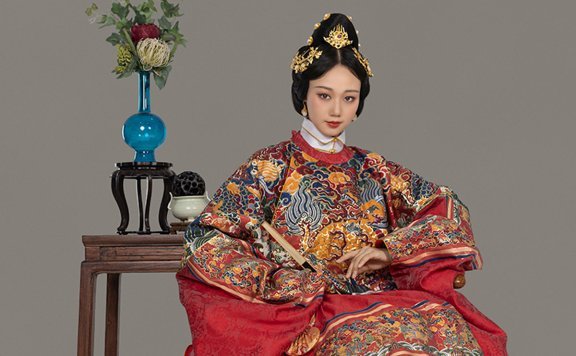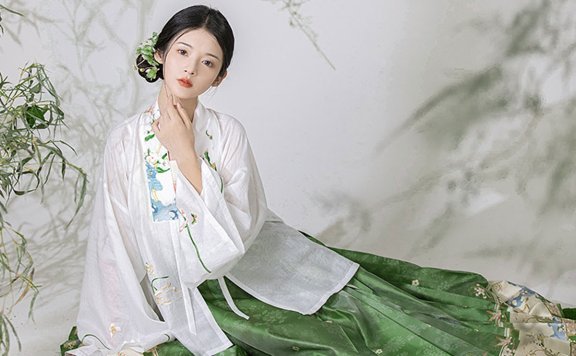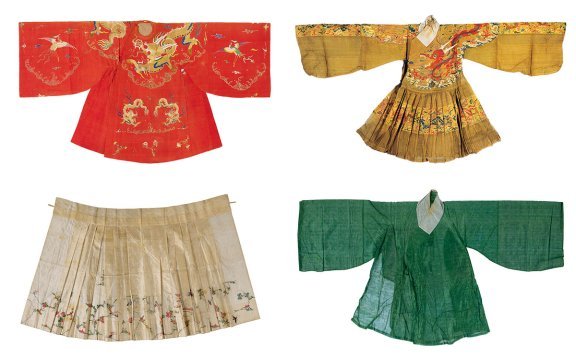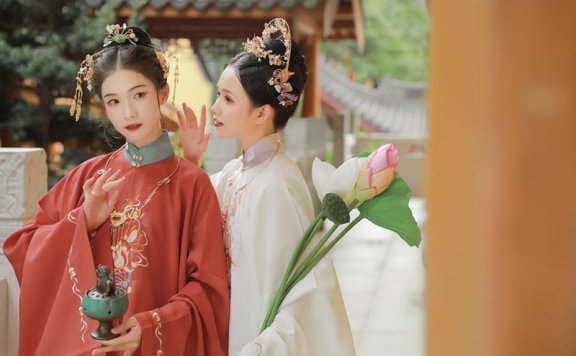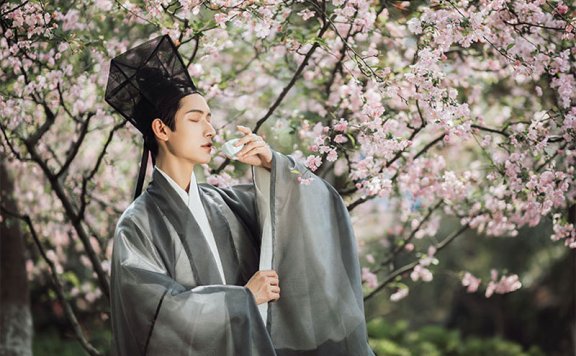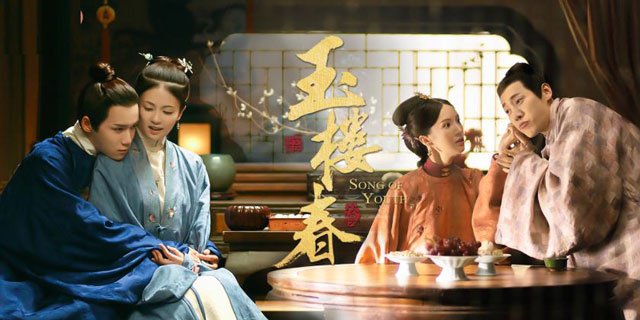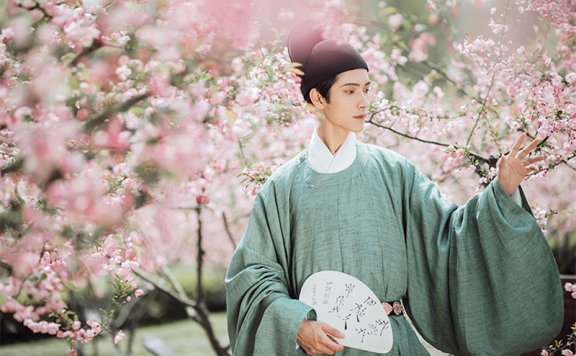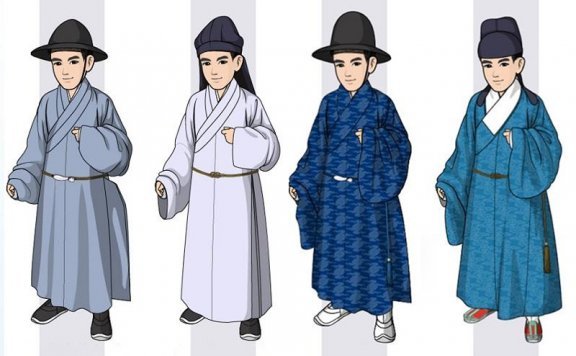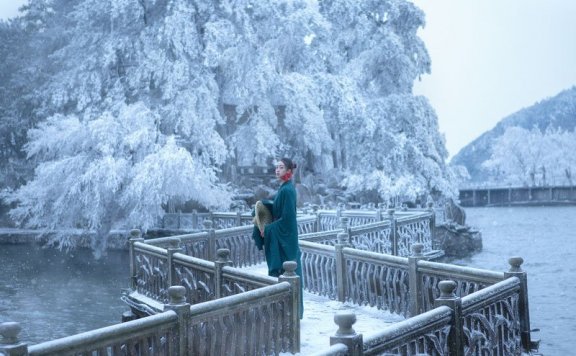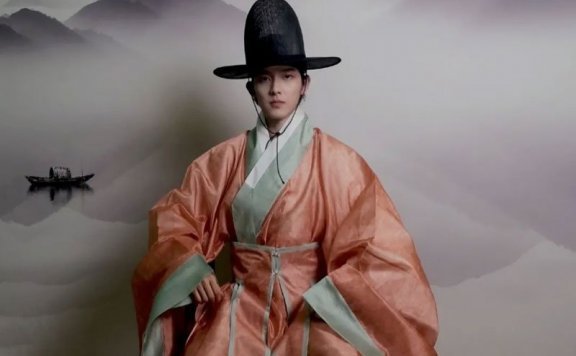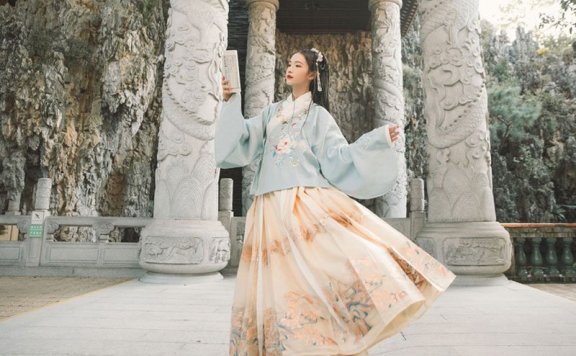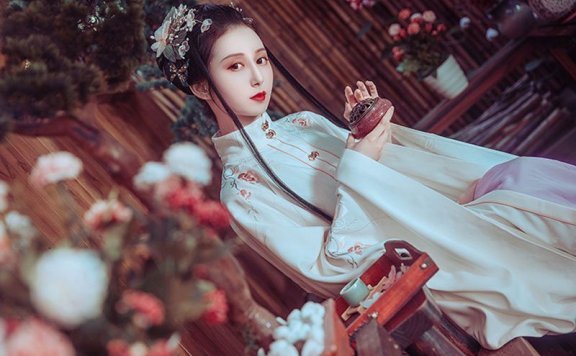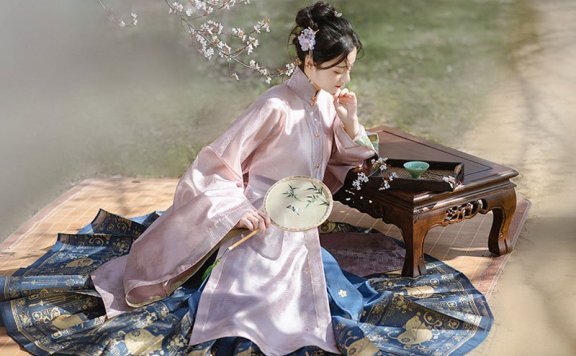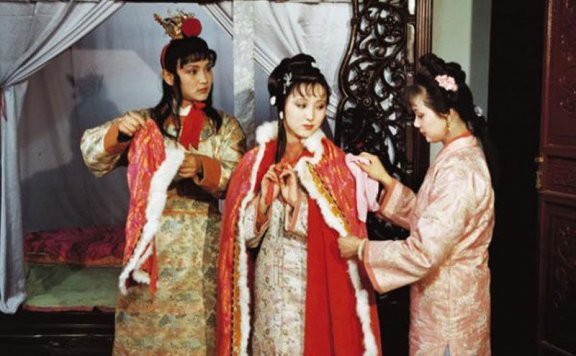-
Classic Hanfu Ornaments in Ming Dynasty Auspicious Costume
The Definition of Auspicious Costume Ji Fu (吉服, auspicious costume) was a new classification of clothing formed in the Ming Dynasty, referring to the clothing used for various auspicious occasions such as seasonal festivals, weddings, birthdays, and banquets. In the Qing Dynasty, it became a specialized category within the clothing system. Traditional Ji Fu refers to the clothing used for auspicious ceremonies (major rituals, etc.). With the development of the times and the increase in festivals and celebrations, there was a need for a special auspicious costume for all kinds of festive occasions, so the Ming dynasty referred to a more formal dress than the everyday casual dress for rituals and all kinds of auspicious occasions as the auspicious costume. Although not found in the system, the term "Ji Fu" was repeatedly used in various political books and literary works. During the Ming dynasty, the auspicious costume was not a single standard style, but the same style as the regular and casual hanfu costumes, such as Yuan Ling Pao, Zhi Shen, Yi San, Tie Li, Dao Pao, Ao Qun, etc. The color was mostly in festive colors such as red, for example, the officials used to wear a red round… -
The Prototype and Development of Ming Dynasty Costume
In the first year of Hongwu in the Ming Dynasty. In order to eliminate the influence of the clothing left by the Yuan Dynasty, Zhu Yuanzhang issued an edict to the whole country, requiring the removal of Hu clothing. However, it was not the emperor who could determine the style of clothing, but the general public. Zhu Yuanzhang's edict on the restoration of the clothes and the crowns did not completely return people's dress to the Tang Dynasty tradition. Even many elements of Mongolian clothing of the Yuan Dynasty were retained because they were convenient to wear on a daily basis, resulting in the formation of Ming clothing of various shapes and features. Ming Style Hanfu vs. Song Style Hanfu For the general Hanfu lover, the difference between Ming Hanfu and Song Hanfu is probably the hardest to tell. Although it is often possible to make some guesses by feeling after wearing it, it is not really easy to pick out a single piece to see. Although there was no mention in Zhu Yuanzhang's edict of restoring clothing to the style of the Song Dynasty, but the Tang Dynasty was a distant time for the people of the Ming Dynasty.… -
Detailed Introduction of Classic Ming Dynasty Costumes
Which emperor paid the most attention to clothing in ancient Chinese history? Then Zhu Yuanzhang, the emperor of the Ming Dynasty, must be on the list. After the founding of the state, Zhu Yuanzhang issued an edict on the restoration of the ancient clothes and crowns, which is about the restoration of the clothes and crowns in the Tang system and the old Chinese. And he personally participated in the improvement of the clothing system. During Zhu Yuanzhang's 31 years in office, the clothing system has been revised and supplemented many times. The clothing system is detailed in terms of fabric, style, size and color. And it regulates the clothing of people of various statuses and identities throughout the country. What's more, its implementation was guaranteed by state coercion. To be arrested for wearing the wrong clothes? This is not a joke at the beginning of the Ming Dynasty. The top-down imperial ban cannot prohibit the awakening of the people's own consciousness and the pursuit of beauty. After the middle of the Ming Dynasty, clothing became more and more luxurious, the official clothing ban was useless, and the art of clothing has shown a prosperous scene of promoting personality and…- 1.1k
- 2
-
What is the Ming Dynasty Hanfu Clothing?
Ming Dynasty Hanfu clothing refers to the clothing system in the Ming Dynasty (1368-1644). At the beginning of the Ming Dynasty, Zhu Yuanzhang, the founder of the Ming Dynasty, inherited the costume style of Zhou, Han, Tang, and Song Dynasties and re-established the costume system in order to rebuild the national pride and etiquette and remove the influence of ethnic minorities. In the middle and later period of the Ming Dynasty, there were some new styles, such as stand collar, and a large number of buttons were used in the conspicuous part of a garment. It was gradually banned during the Qing Dynasty, but there are still a few styles and features that have been handed down to this day. The characteristics of Hanfu in the Ming dynasty In the Ming Dynasty, a series of measures were taken to develop production, which made the industry and commerce develop continuously, and the production technology of each industry has improved. After the rise of the citizen class, the aesthetic interest has become the aesthetic orientation of the general dress in the Ming Dynasty. "Secularization" of the aesthetic and cultural sources and a relatively general, casual, and loose historical and cultural environment.…- 20.9k
- 2
-
5 Classic Hanfu Sleeve Types in Ming Dynasty
When it comes to the gracefulness and elegance of hanfu, the sleeves must take at least half of the credit for the gesture. I believe the deepest impression of Chinese hanfu costumes is that they have wide sleeves. In fact, types of hanfu sleeves are not only wide sleeves, but they also vary in width, length, and posture, so I wonder which "sleeve posture" is most to your liking? Large sleeve Large sleeves (大袖), also known as the wide sleeve, or what we commonly call the "wide sleeve", is known for its wide sleeve width, with the width of the cuff even approaching the sleeve length. It is the most classic sleeve shape of Hanfu, and also the most "fairy" one. The pose of "wide clothes and large sleeves" is the most common in hanfu dresses. Because it is inconvenient to work, it is mostly reserved for the upper class and is often a symbol of etiquette. However, due to changes in the system, status, wearing occasions, socio-economic culture, and other factors, the same large sleeves have different forms. Among the Ming official uniforms, the large sleeves of the "Chaofu (朝服)" and "Gongfu (公服)" was relatively wider, with…- 1.2k
- 4
-
How Exquisite Is the Ming Style Hanfu in Song of Youth
The recently released new Chinese drama "Song of Youth" attracted a lot of people's attention. The drama tells the story of Lin Shaochun, the daughter of an official family, who maintains the relationship between her mother-in-law and sisters-in-law within the Sun family and solves various crises outside to finally achieve a happy and successful life. Many viewers are attracted by the exquisite costume modeling in the drama, praising its detailed and elegant beauty. Then let's take a look at the beauty of Ming Dynasty costumes by referring to the costumes in Song of Youth. I. Ming Style Hanfu The dress and skirt attire of women in the Ming Dynasty was similar to that of the Song and Yuan Dynasties, mainly the upper Shan (衫, shirt) and lower Qun (裙, skirt), but with more attention to details. Its main features are the use of buttons as decoration in the front lapel, small round collars in the inner wear, the standing collars at the neck, and the use of Yunjian (云肩, cloud shoulders), Bijia (比甲) and Xiapei (霞帔), etc. The Ming Dynasty had strict hierarchical requirements for all classes of dress, and although the dress of the commoner women and the…- 416
- 0
-
What You Need to Know About Ming Dynasty Clothing
In recent years, Hanfu has received more and more attention. More and more Hanfu cultural festivals are being held in different cities in China, and worldwide, and thousands of Hanfu enthusiasts are participating in them. The Beauty of Hanfu Is in the Heritage So why is Hanfu so popular? In today's society, people have higher and higher requirements for aesthetics, and the special classical beauty of Hanfu attracts countless people to love it, and then to pay attention to it and understand it. So it is no wonder that Hanfu is so popular. And the beauty of Hanfu is not just on the surface, but in the thousands of years of traditional etiquette and civilization of the Chinese nation that it carries. Today we bring you some of the Hanfu collections from "Yi Guan Da Cheng-Ming Dynasty Costume Culture Exhibition", these collections come from the Shandong Museum and Confucius Museum, most of them are Ming Dynasty clothing, which is not only beautifully made and complete sets, but also very significant for costume research. I hope you can also learn something from these collections. Detailed video about "Yi Guan Da Cheng-Ming Dynasty Costume Culture Exhibition": Based on the previous dynasty,…- 4k
- 4
-
Women’s Clothing Changes During the Ming and Qing Dynasties
This article focuses on the changes in the popularity of traditional Chinese women's clothing from the Ming and Qing dynasties to the early Republic of China. The early Ming dress continues the style of the Yuan dynasty Duanyi (短衣, short clothes), inherited the style of dressing with Duijin (对襟, symmetrical lapels) worn as Jiaojin (交襟, cross lapels) in Song and Yuan Dynasty At this time, also called Dui Jiao Chuan (对交穿). There is also a Jiaoling Youren (交领右衽, wrapping the right side before the left) style. In the mid-Ming period, the sleeve type and skirt door gradually widened, and there was a Tao sleeve (裪袖, sleeve edge protruding from the cuff) structure. According to cultural relics, the stand collar Duijin Shan appeared in the palace system during this period, and was fixed with metal sub-buttons. The style of Dui Jiao Chuan (对交穿) was also excavated in this period, and the more special one is the Mamian skirt with narrow sleeves and thin pleats. Regarding the style of the Mamian skirt, according to the research of excavated cultural relics, the structure of [trapezoidal pleat] and [wide sleeve door] was popular in the mid-Ming period, so there are often drawings showing the outline…- 2.5k
- 3
-
Men’s Clothing Changes During the Ming and Qing Dynasties
This article focuses on the changes in the popularity of traditional Chinese men's clothing from the Ming and Qing dynasties to the early Republic of China. The early Ming dynasty clothing continued the style of the Yuan dynasty, men's clothing in addition to Zhishen (直身), but also have Changshan (长衫) style. At this time the Daopao (道袍) has not yet formed, because the Changshan pleated structure on both sides, inferred that may be the Daopao predecessor. The prototype of the Yisan (曳撒) came from the Yuan Dynasty, and the sleeve shape and silhouette gradually changed in the Ming Dynasty, and developed an outer hem structure, which was one of the common styles of Bianfu (便服)/army clothing or Jifu (吉服) in the Ming Dynasty. The more significant change in the mid-Ming men's clothing is the gradual widening of the sleeve type, the structure of the outer hem is also different from the initial period. Late Ming dynasty men's clothing popular with the Daopao, the initial sleeve type for the bias to straight sleeves, with the structure of the Shoumei (收袂). At the end of the Ming Dynasty, the robe has developed into wide sleeves, and the structure of the inner and…- 2.8k
- 1
-
Why Ming Dynasty Hanfu Appropriate for Winter Wear?
Today there is an almost universally accepted saying among Hanfu enthusiasts that the Ming dynasty Hanfu is suitable for autumn and winter and the Tang dynasty Hanfu for summer. The Song style is best for modern times and can be worn in every season. But why is this? Could it be, simply because historically the Tang dynasty was hotter, the Ming dynasty colder, and the Song dynasty closer to the present? Follow along with Dongfang Zhuangdao to find out more! In fact, in the light of current phenological studies, this statement does correspond to historical climate trends. Mr. Zhu Kezhen (竺可桢先生), the founder of modern Chinese geography and meteorology, and a leading figure in the field of phenology, has studied the main trends of climate change in China over the last 5,000 years, using the 20th-century climate as a benchmark for comparison, and concludes: in ancient China, there were four warm periods, the Yangshao periods (仰韶时期, 5000 BC to 3000 BC), Yinxu periods (殷墟时期), the Spring and Autumn & Warring State periods, the Sui and Tang periods, and four cold periods, the late Shang and early Western Zhou periods, the late Northern Song and early Southern Song periods, and the…- 1.2k
- 1
-
Chinese Traditional Costume - Ming Style Daofu for Male
Previously we have discussed the Ming Dynasty men's clothing: Zhiduo (直裰), Zhishen (直身), and Taoist robe (道袍). And today we are going to discuss the Daofu. Daofu (道服, Dào fú) has two meanings in Chinese: refers to Taoist clothing, the robes worn outside by Taoists; one of the Chinese traditional costume Hanfu styles: Ming Dynasty costume for males. Obviously, they are different kinds of clothes, today, let's learn about the traditional sense of "Daofu" through the Hanfu Culture Society! [Structure and History] Daofu, Jiaoling Youren (交领右衽, wrapping the right side before the left), wide sleeves, with dark edging at the collar edge, sleeve edge, and placket, sometimes with a Huling (护领, collar protector) in collar edge. Daofu: Jiaoling Youren (交领右衽, wrapping the right side before the left); wide sleeves; with dark edging at the collar edge, sleeve edge, and placket; sometimes with a Huling (护领, collar protector) in collar edge; the slit is embellished with an inner hem; both inner and outer have the strap; In simple terms, it can be seen as a "Taoist robe" with edges added. In fact, the similarity between Daofu and Shenyi can be seen through its appearance, it is a style inherited from…- 1.2k
- 0
-
How to Wear Hanfu (7): Ming Dynasty Jiaoling Aoqun
Aoqun(袄裙), most commonly wore during the Ming Dynasty. Let’s take a look at the individual pieces and how to wear them. The History of Aoqun The word Aoqun translates into a lined top and skirt, it is one of the earliest and most basic forms of Hanfu. This style was developed as early as The Warring States period (475 BC) as seen on these clay figurines, and it evolved throughout the dynasties. By the mid to late Ming Dynasty, it had become the most commonly-seen design for fall-winter clothing among wealthy families and the royal court. There are also many historical relics available for us to study. Wear the Skirt of Aoqun Aoqun is outerwear, so people usually wear inner garments made of cotton or linen material underneath. During the Ming Dynasty, women usually wear Mamian skirts or pleated skirts, this one is a one-piece half-pleated skirt with the pleats only on top, and embroideries on the bottom, as well as on the belts. There are usually two types of one-piece skirts, one style you insert the belt through a hole in the middle, the other style uses an extra set of ties. This skirt doesn’t have either…- 1.6k
- 0
-
How to Wear Hanfu (6): Ming Style Standing Collar Jacket
As winter approaches, more and more Hanfu enthusiasts are focusing their attention on the Ming style Hanfu. Whereas in the Ming style Hanfu costume, the combination of an Ao (袄, jacket) on top and a Qun (裙, skirt) on the bottom is especially popular. Ao has several types of collars, and today we are focusing on the standing collar today, briefly introduce the history and how to wear it. History of the standing collar Some of you might recognize the standing collar as the mandarin collar, most people think the standing collar is derived from Qing Dynasty Manchurian dress, also known as the cheongsam or qipao, but it is actually originally invented and passed down from the Ming Dynasty, the dynasty before the Qing Dynasty, it is a part of the hanfu system and was later on adapted into Manchurian dresses, and today it’s widely known in the world as the mandarin collar, and recognized as one of the most distinctive features of Chinese clothing. Do you remember this Ming Dynasty painting? Almost every woman and child are wearing the cross collared Aoqun, showing how popular this style was at that time. However, when we look more closely at…- 900
- 3
-
Nice Ming-style Chinese Dress for Girls (Summer)
Every hot summer, many girls will feel that Song-style Hanfu is the first choice for this season, indeed, with the cool and soothing touch of skin, many people will be willing to choose Song-style Hanfu to spend the summer. In fact, in addition to the Song-style Hanfu, the Ming-style Hanfu is also a kind of "Summer Hanfu"! Even in the summer heat, Ming-style Hanfu can still "make a splash"! The difference between Ming-style Hanfu and Song-style Hanfu Song-style Hanfu: Song Hanfu is the most suitable Hanfu for summer because it is the most simple Hanfu. Due to the background of the Song Dynasty, Song Hanfu are mainly slim and long, with narrow sleeves and cross collars. The "Beizi" and "Song trousers" are the main styles of Hanfu in the Song system. Ming-style Hanfu: In the beginning, the Ming Hanfu has always been regarded as a noblewoman's Hanfu, and because the Ming Hanfu is mostly based on horse-faced skirts, its craft is complicated plus the fabric and silk are expensive, so the price of Ming Hanfu has always been high. The "long jacket" and "short jacket" plus the "horse-faced skirt" also became the main style of Hanfu in the Ming…- 472
- 0
-
What’s the Difference between Cloak and Cape in Hanfu?
In Hanfu, "Doupeng (斗篷, Cloak)" and "Pifeng (披风, Cape)" are often confused. It seems that there is no difference between them in Hanfu. But in fact, they are totally different things. Today, we will introduce the difference between them. "Doupeng (斗篷, Cloak)" Doupeng, it usually has a stand collar, no cap, no sleeve, and generally has a slit at the back. It's usually matched with a hat. Cover the whole body to prevent wind and cold. And the design of the Doupeng is not convenient for the hands to move, so it just keeps people warm. Doupeng, evolved from coir raincoats, was originally made of hemp to resist rain and snow. In the Ming and Qing Dynasties, silk fabrics were widely used in Doupeng, not limited to rainy and snowy days. It was a kind of clothing to keep out the cold, with long and short styles, high collar, and low collar. When going out in winter, both men and women, officials, and people like to wear Doupeng, but there's a rule that you can't be salute in this kind of dress, or it's considered disrespectful. After the middle of the Qing Dynasty, women's cloaks were very common, and…
